|
|
November 1, 1998
I want to put down some stories told to me by Retty Lawrence. These are from our last Wednesday tour to a site at Sokehs. The site is the one used by the University of Oregon bunch as the training ground. It is a prehistoric village with stone platforms and a path, a well that was used until very recently, and some modern remakes of platforms by the road. One platform has been used for copra drying; another was pretty much torn up by the road construction, with the remains of the platform just piled up by the road (there is a bunch of midden mixed into the stones in this pile, and includes some ash, darkened soil, shell, bone); another platform or two were reworked to make a pig pen. There is an oven just off the path, but it is anyone's guess if it is recent or not. And the well has an overflow area, also paved.
The site name is Nanimwinsapw Naneir, Po-S2-2. It is a large residential complex that runs from the mangrove to the base of Sokehs Rock, across a series of terraces on which more platforms are placed. Whether the stone path continues to each of these terraces and platforms is anyone's guess. To get from one terrace to the other, however, Retty said there are some very well made rock steps. One of our tasks while there was to actually place the site onto a map. This detail was neglected by the University of Oregon guys. What they did was to create a map of a small portion of the site, but left it floating in space. I triangulated the site position (at least where their map began), placed it on the map, and then had Retty do the same.
Retty told stories the whole time we were out. It was absolutely marvelous. Concerning a certain split rock we passed ---
It seems that a long time ago that there were two boys who liked to play in the water, but their mother didn't like it too much. She would tell them that it was not good to play in the water so much. When they would go out and play, they would call down a rock from above, and send it back up to where it had come from. Soon the rock became tired of this game, so it just stayed down. It refused to go back up. So the boys continued playing under the rock. Every day the mother would call to them, Where is the tide now? She would do this in song (Retty sang). They would respond, It is to their ankles, their knees and so on. One day they continued their response, To their hips, their waist, their shoulders --- then the youngest didn't respond. The tide had gone over his head and he drowned. The other one continued, to his neck... The mother became very worried, and wanted to get her boys back. She called upon a certain magical fish to help save her boys. The fish broke the rock in two and the bodies of the boys floated up. They were dead.
Another of the stories goes like this ---
In the cliff face of Sokehs Rock there is a cave where terns nest. People would climb to the top of the rock, throw a rope down and climb down to the cave to collect terns and eggs. Once, there were two men: one was married, the other was not. The single man was having an affair with the married man's wife. One day the single man and married man went to collect terns. The single man threw one end of the rope down and told the married man to go to the cave first. When the married man reached the cave, the single man threw the other end of the rope down. The married man was trapped. He could not climb up or down out of the cave --- it is a very steep cliff. The single man thought that was the end of the married man, so he took off with the wife. The married man, however, just sat in the cave and collected terns as they came into the cave. He would tie each one to the rope, and as soon as he had enough, he flew out of the cave hanging onto the rope with terns. He saw the single man with his wife and began to plot his revenge. He caught a kind of fish that when it is cooked, its skin just slides off. Terns like this kind of fish. When the man and his wife were sleeping, he slipped the fish skin over the man's penis and invited the terns to have a feast. They ate the man's penis. End of story.
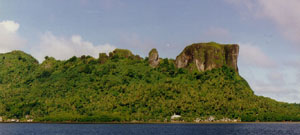
The road we followed onto Sokehs Island is recent, but it is actually built on top of the German road, a raised path built of coral. A foot path. The German road is one of great controversy: it is the site of the Sokehs Rebellion --- which I need to find out about. I don't really know what was involved here, other than that there are local families who still feel the pain of the slaughter. No one is supposed to speak of or write about the Sokehs Rebellion during this generation because of the pain of the relatives; the path is in essence a monument to their lives and struggle.
The new road is the product of many negotiations between the Forestry people, Public Works, Marine and Wetlands people, and Historical Resources. The road mostly goes through the mangrove, so it represents an environmental impact of the greatest magnitude. It mostly follows the German road, and is built on top of it; in essence, it denigrates the integrity of the raised stone path, the German road. The current road cuts over, across, and through the German road; it chops it into pieces. One has to wonder if it was ever documented or mapped --- at least transferred onto paper.
There is also a waterline built across and on top of the German road. The new road also blocks the fish migration into the lagoon. Retty was saying that a certain kind of fish, a big fish that traveled in great numbers, used to come during high tide into the mangrove. People used to lay in wait for this fish migration. But, with the building of the road, the fish can no longer migrate into the mangrove. Their passage is effectively cut off. Retty put it as a choice between fish and a road; the road won.
November 2, 1998
We had to take Teresa's taxi, of course. But they are so nice. I really like them. You would like Teresa's taxi driver --- Silihter Plus. A very large woman who likes to talk. On our drive to Rufino's office, she not only picked us up but another old man as well, and the whole time she was talking to the old man. Silihter's voice is very pleasant and therefore really nice to listen to. We didn't understand a word she said to the old man, but she made us feel quite comfortable.
November 4, 1998
I think to be an oral historian who can relay stories to those who do not speak your language is a very hard job. Julie can do it, so can Retty, so can Vince. Part of their ability comes from an awareness of the American mind, I think. They have spent a lot of time over here going to school. But also, they are quite intelligent, sensitive, and have an awareness of history that does not seem to be instilled in very many people. These guys have a unique gift --- they are story-tellers. I can listen to them for hours on end.
It is because of Julie that I gained such an awareness and understanding of Palau, what it is to be Palauan, and how they perceive the imminent loss of their traditions with the globalization of their culture. I never spent a lot of time with Vince, but that small amount of time I did spend was listening to marvelous stories. I am getting to spend some time with Retty --- and I look forward to every moment of it. I wait for Wednesdays. Those were the days we agreed would be our field days, when we could get the jeep.
We simply have to go back out tomorrow. We tried to finish our reconnaissance of several proposed well-drilling locations for a municipal water system, but we were unsuccessful --- so, we continue tomorrow. I am looking forward to it. I have the camera loaded with film and intend to take more pictures. I know Retty will have more stories, too.
We also lucked out and got a car and driver from the company who submitted the proposal for construction of the water system (a Korean company). It is a real nice four-wheel drive, with air conditioning and a very good stereo system. We seemed sort of out of place driving through the jungled areas on the island, while also listening to Retty narrate various tales about the features of the land that we passed. I felt like we had our feet in two worlds --- the ancient world of the stories and the modern world of the car. The car reminds me of our drive last week around Sokehs. It was just me and Retty in the jeep and he drives really slow --- so slow that he would brake for any creature crossing the road. I didn't see many of them; one in fact was a small chick. Just a chick, but he slowed to a stop and waited for it to cross the road. He did the same for a land crab. The kid driving today did not slow as much; he drove just a wee bit too fast on the unpaved portions of the road. He's a nice kid, though, and has a great name --- New Year Martin.
November 4, 1998
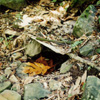 |
I don't know if I mentioned it yesterday, but I got some pictures of a traditional well. It's somewhat hard to see, but I think you can make out the details in the photograph well enough. It is only a shame that I will have neither the time nor opportunity to explore these kinds of features and place them within some kind of context. There are many, too many for the limited time I have here. |
I also took some pictures of some landscape features that have important tales associated with them. One story goes like this ---
Once, there were two giants. One, a man, the other a woman. The man looked upon the woman, who was some distance away. The man giant wanted to make love to the woman giant, so he did some magic to make his male member really big and projected it up to her through the mountains. But he missed, in consequence of which there is now a really lovely prismatic basalt outcrop on this one mountain where his excited portion pushed up the rocks. It is just the shape of the tip of his member. They became the mountains.
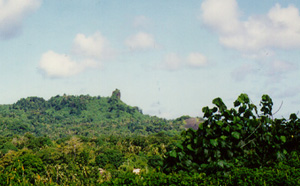
Retty Lawrence, New Year Martin, and wife of land owner on Temwen Island. Retty would do the interviewing.
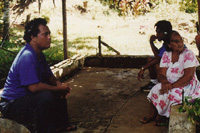
Part of our municipal water proposal took us to Temwen Island, and the land owned by Pernar Perez and Iasio Perez. I took a picture of them at their home on Temwen Island. She is the sister of the late Nahnmwarki, and both of her older brothers were Nahnmwarkis. The door in the picture is one of the entrances to the nas, a u-shaped structure that was traditionally a men's house and used for sakau ceremonies and general meetings of importance. The nas in the photo is all concrete, and of their own unique design. It follows the general floor plan of a nas --- u-shaped, certain number of posts and all that. But then it begins to deviate --- concrete (more and more of them are concrete), with semi-room partitions. They have turned it into a house, an open house more or less, but with semi-rooms --- partitioned space inside the nas, along the flooring. Normally there are no doors at the ends of the nas; the ends are open, just as the u-platform flooring is open inside the structure. These little people have turned their nas into more of a living place, with partitions, elaborate brickwork on the main flooring for one of the partitions, doors going from one partioned space to another.

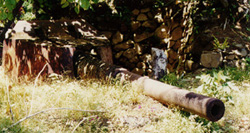 |
Japanese gun emplacement. WW II
|
 |
Japanese bunker. WW II
|
November 5, 1998
One place we went was a Japanese fortification at the very top of Temwen Island (the island Nan Madol is connected to). The guns, bunkers, base tower for the searchlight are all there. The site is on private land (most land here is private, which means people own the sites), this one owned by Pernar and Iasio Perez. They simply tottered about, laughed a lot, and were so full of life and energy. I think their charm was in their laughter. The man used to be a messenger for the Japanese. He had to run across the islands delivering messages, and he would be timed because the Japanese knew how long it would take to get from one place to another.
Watching Retty with these people and some of the other people from whom he had to get permission for us to cross the land, was interesting. He has a calm about him that puts people at ease and lures them into telling their stories. The kid, New Year Martin, said to me later that he never would have heard any of these stories if he didn't come with us.
We also saw the location of a Spanish fort --- only the moat remains, and that is mostly filled in with soil. The community is building a Protestant Church on the site. The Spanish road to the fort is still used today and has had little improvement. (We drove along it from the channel and pier built by the Spanish, also still used today. As for the road, only one section has a layer of coral on top of it; otherwise, it remains essentially the same.)
I am writing legislation now for Pohnpei State, and after reviewing the legislation that created this office, there is nothing in it about preserving sites, or anything else. So, I am in the process of doing several things --- making a Site Register equivalent to the U.S. National Register. Nan Madol is on the U.S. Register, which means it is supposed to receive certain levels of protection, but as things now stand I can see Nan Madol being gradually eaten away, just like a quarry where those big prismatic basalt columns were mined. A Japanese firm was given permission to get some basalt columns there, and then there is the German Road that was the site of the Sokehs Rebellion --- an historic event I need to try to research. The latter was cut up by road construction, with no effort to document the historic materials.
We also came across an interesting problem while we were out on our municipal water systems reconnaissance. A household wants to drill a well on their property, but a very important subterranean water source flows along the same route, and the well would intercept this water. The water source comes out at the shore line --- an infusion of fresh water in the lagoon. Once, according to Retty, it came out farther into the lagoon and created a very large pool of fresh water. The source is important because it is tied to a high-ranking priestly title on the south side of the island (the water source comes out on the eastern side of the island). The water stops flowing when the priest dies; it begins to flow again when that title is handed to someone else from that same island section on the south side of the island. But, in the 1960s or 1970s, when the water stopped flowing and the priest died, the Nahnmwarki (responsible for naming the successor to a title) named someone from a different part of the island altogether to that title. Since then, according to Retty, the water has continued to move around; it never flows in the same place because the title was bestowed upon someone from a different island section. One more thing about this water flow: in the old days, when all things were going right in that section on the south side of the island, the water flow was blue in color. So, based on oral history and the importance of this water flow to that history, this well may be denied. It is a question that must now be put to the section chiefs --- they must decide if this water source can be altered, because by altering it, they are also tampering with tradition and history. It is an interesting world here.
Next: Kolonia
|
|
|